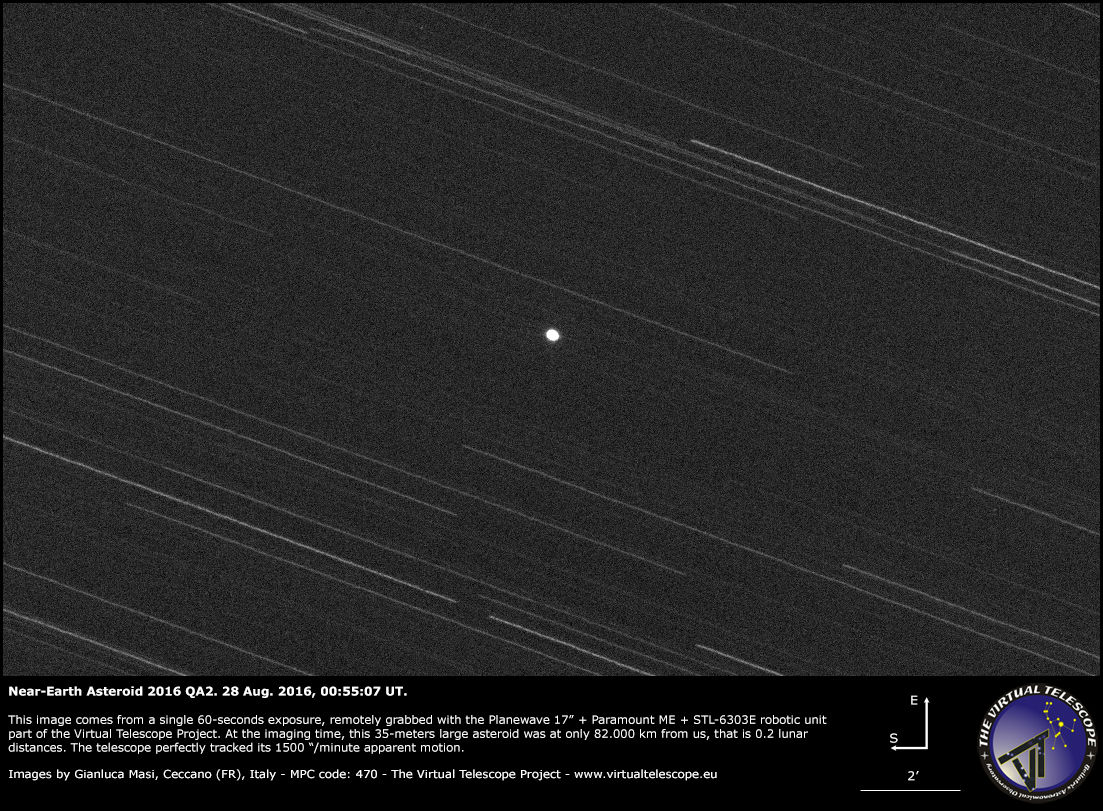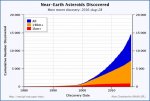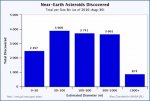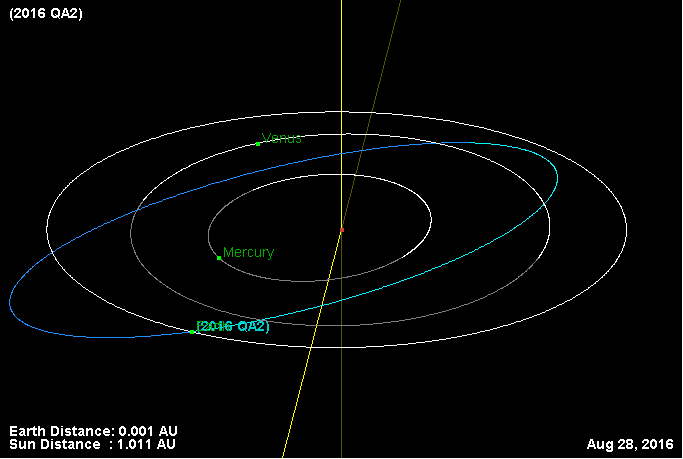For links see article source.....
Posted for fair use.....
http://www.sciencealert.com/a-huge-previously-undetected-asteroid-just-came-very-close-to-earth
A huge, previously undetected asteroid just came very close to Earth
Everything's fine.
BEC CREW
31 AUG 2016
A 35-metre-long asteroid just came unusually close to Earth, and we barely even saw it coming.
Despite the fact that it got less than a quarter of the distance between Earth and the Moon away from us, no one even knew it existed until a day before its relatively narrow flyby.
Now, let’s not pretend this thing was ever going to hit us - the closest it got to us was no more than 100,000 km away. But how did something so big sneak up on us like that?
Detected by the International Astronomical Union’s Minor Planet Centre (MPC) - the official worldwide organisation for collecting observational data on minor planets, asteroids, and comets - the newly discovered asteroid, called 2016 QA2, swung into view on Saturday August 27.
It then made its closest approach to Earth on Sunday August 28, with the MPC tweeting that it’s estimated to be between 16 and 42 metres long, and got within 0.22 lunar distances of the surface of our planet (1 lunar distance is 384,400 km or 238,900 miles).
It’s not so unusual that we didn’t notice an asteroid.
NASA estimates that over 90 percent of the near-Earth objects (NEOs) larger than 1 kilometre have already been discovered, but so far only 30 percent of the 160-metre (460-foot) NEOs have been found, and less than 1 percent of the 30-metre (100-foot) NEOs have been detected.
An asteroid or comet is classified as a near-Earth object if its closest approach to the Sun is less than 1.3 astronomical units (AU), with 1 AU equalling 149,598,000 km or 92,955,887 miles.
These little space rocks are the ones that keep us on our toes, because they're simply too small for us to detect until they get close, but they're big enough to cause some real damage if they actually make an impact.
Add this to the newly discovered asteroid's weird orbit, and we've got the makings of a surprise flyby.
As Ria Misra explains over at Gizmodo, "If you look at the path of 2016 QA2 below, you can definitely see it come close to Earth for its weekend flyby - but more broadly, its elliptical orbit means that it spent a lot of time out in the further planetary regions by Mercury, Venus, and Mars."
Graphic - Created by Gizmodo using NASA JPL’s Small body database observer
So we live to see another day, and wave goodbye to another space rock.
At least the flyby gave the team at the Virtual Telescope Project something to look at - check out this awesome shot of asteroid 2016 QA2 they managed to capture as it went whizzing by:

http://www.sciencealert.com/images/2016-08/asteroid-aug.jpg
Posted for fair use.....
http://www.sciencealert.com/a-huge-previously-undetected-asteroid-just-came-very-close-to-earth
A huge, previously undetected asteroid just came very close to Earth
Everything's fine.
BEC CREW
31 AUG 2016
A 35-metre-long asteroid just came unusually close to Earth, and we barely even saw it coming.
Despite the fact that it got less than a quarter of the distance between Earth and the Moon away from us, no one even knew it existed until a day before its relatively narrow flyby.
Now, let’s not pretend this thing was ever going to hit us - the closest it got to us was no more than 100,000 km away. But how did something so big sneak up on us like that?
Detected by the International Astronomical Union’s Minor Planet Centre (MPC) - the official worldwide organisation for collecting observational data on minor planets, asteroids, and comets - the newly discovered asteroid, called 2016 QA2, swung into view on Saturday August 27.
It then made its closest approach to Earth on Sunday August 28, with the MPC tweeting that it’s estimated to be between 16 and 42 metres long, and got within 0.22 lunar distances of the surface of our planet (1 lunar distance is 384,400 km or 238,900 miles).
Minor Planet Center ý@MinorPlanetCtr
Asteroid 2016 QA2 discovered. Flyby Aug 28 at 01:24 UT. Dist: 0.23 LD (0.22 LD from Earth surface). Size: 16-52 m. http://bit.ly/2bqks7f
6:30 PM - 27 Aug 2016
28 28 Retweets
29 29 likes
It’s not so unusual that we didn’t notice an asteroid.
NASA estimates that over 90 percent of the near-Earth objects (NEOs) larger than 1 kilometre have already been discovered, but so far only 30 percent of the 160-metre (460-foot) NEOs have been found, and less than 1 percent of the 30-metre (100-foot) NEOs have been detected.
An asteroid or comet is classified as a near-Earth object if its closest approach to the Sun is less than 1.3 astronomical units (AU), with 1 AU equalling 149,598,000 km or 92,955,887 miles.
These little space rocks are the ones that keep us on our toes, because they're simply too small for us to detect until they get close, but they're big enough to cause some real damage if they actually make an impact.
Add this to the newly discovered asteroid's weird orbit, and we've got the makings of a surprise flyby.
As Ria Misra explains over at Gizmodo, "If you look at the path of 2016 QA2 below, you can definitely see it come close to Earth for its weekend flyby - but more broadly, its elliptical orbit means that it spent a lot of time out in the further planetary regions by Mercury, Venus, and Mars."
Graphic - Created by Gizmodo using NASA JPL’s Small body database observer
So we live to see another day, and wave goodbye to another space rock.
At least the flyby gave the team at the Virtual Telescope Project something to look at - check out this awesome shot of asteroid 2016 QA2 they managed to capture as it went whizzing by:

http://www.sciencealert.com/images/2016-08/asteroid-aug.jpg

 90% is optimistic 'feel good' talk from NASA...
90% is optimistic 'feel good' talk from NASA...







